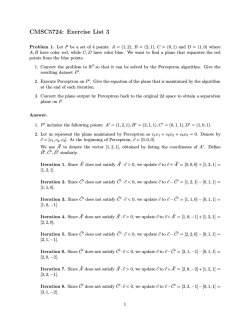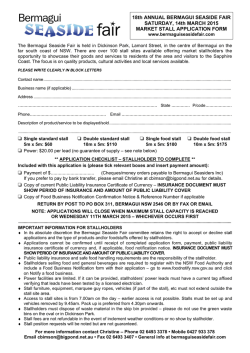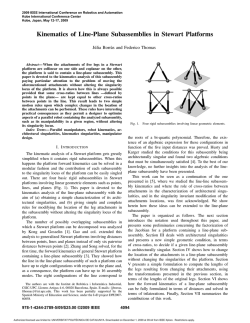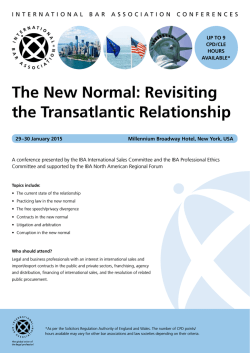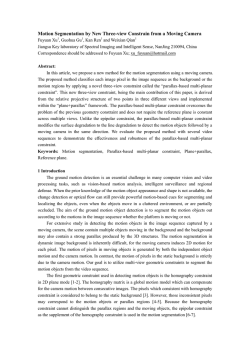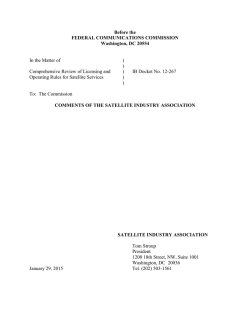
a causal study on the airasia airbus crash event
A CAUSAL STUDY ON THE AIRASIA AIRBUS CRASH EVENT Sohei Matsuno & Bahrul Ilmi, IBA Univ., Palembang, South Sumatra, Indonesia E-mail: [email protected] ABSTRACT This Paper is of a preparatory study for due-diligent studies on the inscribed Event, ‘The AirAsia Airbus A320-200 Crash in the Java Sea near the south Sumatra on Dec. 28 2014.’ The Writers (of this Paper) refuse currently circulating ‘weather/pilot-error’ centered causal hypotheses, regarding them as preparatory works to make the hypotheses be a theory. Their growth must be checked from their infancy, i.e., while they’re in a hypothesis stage. The purpose of this Paper is to forward an ‘air-pressure-fatigue’ causal Hypothesis against the current backdrop. To realize this purpose, this Paper firstly confirms time-line records of the Event, defines two key technical terms, ‘fatigue’ and ‘cause,’ and introduces two episodes: (i) talks with AirAsia officials on a reparation matter in 2014 and (ii) Primary-type glider exercises at Japanese junior high schools in early 1940s, to help readers’ better understanding. Secondly, it criticizes the hypotheses. Thirdly, it inductively works out its Hypothesis based on currently-applicable data, in which it inductively concludes that the cause of the Event is the fatigue fracture in a cockpit at a panel joint. Last, it gives due-diligent studies a deductive way to prove its Hypothesis, by concretely directing, ‘on what matters the due-diligent studies shall focus,’ when physical items will emerge from the recovered plane fuselage and the matters. Keywords: AirAsia Airbus crash, fatigue fracture in cockpit joint, snare in budget system INTRODUCTION Background of this Paper The Writers aren’t specialists in aeronautics. However, through their past causal studies on various structural / mechanical failures (cf. REFERENCE: [1] ~ [12]), they have learnt a common tendency in worldly causal studies (the studies), regardless of study objects (bridge, building, vehicle etc). The studies used to commence with comments of experts and authorities who are often well connected to involved-in-case building, manufacturing and/or operating organizations. The comments admire of the involved organizations of their high-degree track records, and allude to a cause of natural phenomena of as global as possible (climate, quake, flood etc). On the one hand, the design, construction (manufacturing) and maintenance of any important realities (structures and products) are obliged to abide by the respective specifications that assume a criterion for each phenomenon of the highest probable intensity. Hence, any phenomenon eligible for a cause must be such that’s being beyond human knowledge. To let it be so, any supportive theory, e.g., ‘climate change,’ is mobilized. If it’s successfully done, every organization concerned could be released from responsibility for the case. If not, at least one more complementary cause must be found to set up a compound-cause. For this need, what are often conveniently sought are human errors of victims who are no longer able to tell their own tales. The above tendency is consistent unless otherwise undeniable evidence is thrust before everyone concerned. 1 According to a series of media information, the Event seems to be on this ordinary course. Given the situation, the Writers cannot help forwarding their causal Hypothesis before the people. Comment: Accidents in a nuclear power plant and an aircraft, both of which are closely related to muss-destruction weapons, ‘nuke,’ and its transportation means, ‘airplane,’ are top-2 secretive events in causal studies. Timeline of the Event According to media reports, it’s as follows (all local time): 5.36am: QZ8501 departed Juanda Airport, Surabaya in the Java Is. 6.12am: Pilots contacted Jakarta Air Traffic Control (JKT ATC) centre, having requested weather deviation and a climb in altitude. 6.14am: A conditional permission was granted two minutes later, but no response from the crew followed. 6.16am: JKT ATC center couldn’t contact QZ8501, but the plane was still observed on radar. 6.17am: Radar contact is lost. 6.18am: The contact signal has extremely disappeared. Only a flight plan view remained on radar screen Comments: (i) A trouble happened on the plane between 6.12am and 6.14am. (ii) The plane plunged into water at 6.18am. (iii) During this 4 ~ 6 minutes, the pilots did (or could do) nothing even sending a distress call. Questions are two, viz.: (i) What was the behavior of the plane when the trouble happened? (ii) What kind of trouble was that that made the pilots do (can do) nothing and few passengers wear life jackets? The cause of the Event can be found in the answers to these two questions. Definition of technical terms (1) Fatigue When a material in a structure is subjected to alternating stress, it’s broken at a stress lower than its static ultimate strength. This phenomenon is called fatigue. The greater the alternating stress is, the smaller the number of cycle until rapture occurs is. The fatigue doesn’t occur if the alternating stress is less than certain intensity. This stress is called fatigue limit. No material is immune to fatigue. (2) Cause A causal study should be based on a rightly defined technical term ‘cause.’ This Paper shall give it by showing extracts from one of the Writer’s past study reports [1]. It says: A cause is, ‘a thing that makes a consequence to happen.’ If the cause (hence, the consequence) is reversible, the cause is, ‘the thing whose removal brings about an immediate cure of the consequence.’ [Explanation] 2 Any consequence has generally a single cause that’s particular in an object where the consequence happened, and is often man-made. When a consequence happened by a series of things, the last one that directly caused the consequence is eligible for a cause. Others are preparatory conditions. It’s likened to dominoes. A fall of a domino at just one point before the last one is the cause of the last one’s fall. The last domino can stand again only when a domino of one point before it is removed. The cause of this pattern is difficult to identify but, once identified, easy to deal with by human efforts. Any common factor, such as a global or universal entity can’t be a cause, unless it’s plural and exist in heaps only on the object. It’s called a compound-cause that is usually sought by someone who can’t identify a particular cause. The compound-cause effectively contributes to making a really responsible cause be vague. The causes of this pattern are easy to mention but practically impossible (even if they’re true) or absolutely impossible (if they’re false) to cope with because of their universality. Whenever a ‘particular cause’ has been found, even if it’s the consequence of the ‘compound-cause’, the latter must be replaced by the former, ranking down the latter to the ‘preparatory conditions.’ A universal or global thing can be a cause only when it’s a thing that’s newly discovered by the consequence. In this context, Isaac Newton could say, ‘Terrestrial gravitation is a cause of an apple fall from a tree,’ but the same can’t be said for an airplane fall from the sky. Any cause that doesn’t satisfy the above definition is not eligible for the name of ‘cause’ at least in this Paper. Episode 1: Talks with AirAsia officials The talks were held at Kuala Lumpur and Tokyo on Oct. 14 and 15 2014 respectively, having had a reparation matter on the agenda. The talks were generalized when the talks covered a budget system. On Oct. 14 2014, one of the Writers was a transit traveler at the Kuala Lumpur International Airport 2 (kulia2) to Tokyo Haneda International Airport (HND), after a flight with AirAsia AK452 from Palembang to Kuala Lumpur. At kulia2, he was told at a check-in counter of the AirAsia flight D7 622 to HND’s delay from slated departure time, 2.40.pm to 4.50.pm. There was no notice on the delay. The consequential arrival-time delay was from 10.30.pm Oct 14 to 12.40.am Oct.15. As no public service (transportation, bank etc) is active at that time, the Writer asked the costumer service section chief at kilia2 (Mr. J.) any alternative sooner flight. He replied, ‘No sooner flight is.’ He added, ‘This is a matter of an arrival airport office. I shall inform them of this case. They’ll manage the matter properly.’ The talks lasted for about 15 minutes in English. Several other staffers were there too. When the Writer arrived at HND, he met two female staffers (O1 and O2) from AirAsia’s agent company in Japan, All Nippon Airways, first. They said, ‘AirAsia is rigidly governed by its budget system. It doesn’t allow participating in any item that exceeds the scope of the relating budget item. Any damage happened outside its flight, even if it is related to the flight, is not their business. Your matter is of this case. Hence, it’s impossible to meet your cause. AirAsia’s cheap flight fare owes to this budget policy that limits budget items extremely compressed to minimum necessity. Every passenger agrees to this policy and use AirAsia. If you don’t agree to this policy, you should use other flights.’ When asked to make a memorandum of the talks, they said they weren’t in position to do it, and called AirAsia staffers as the Writer requested. Two AirAsia staffers (one female, T.) and another (male, not introduced himself and kept silent 3 throughout the talks) joined. Ms T. confirmed the points previously told by their agents. She complemented it as follows: As to the delay notice, she said, ‘It’s unconceivable that the delay notice wasn’t delivered to any particular passenger, since the notice was sent to all passengers’ email addresses automatically in one action. If any message didn’t reach any passenger, that’s not our fault. As for AirAsia kulia2 staffer’s statement, ‘The matter will be properly settled at AirAsia’s HND office,’ she said, the word ‘properly’ didn’t necessarily mean ‘in favor of you.’ As to your damage, ‘You can claim it to any insurance company that you’d concluded a contract before your departure. To support it, we shall issue a delay certificate. That’s all what we can do.’ The writer asked her a key question in a casual manner ‘Is the budget policy common for all other subjects without exceptions?’ She replied, ‘Yes, it is.’ She agreed to make a memorandum. She asked me, ‘For what purpose do you need it? If it’s for a legal process, it’s useless. You can’t win, since our company’s operation has been permitted with this policy.’ The Writer replied that it was for his further studies. The memorandum that agrees to the above talks in principle was made without discord. She further advised, ‘You can go to your hotel with a taxi, or, if you’d prefer to, you can wait the first monorail here. It’s only a 3-hour wait,’ having pointed to benches where several people, who were probably under a similar fate to the Writer’s, were wearily sitting. Last, she said, ‘Have a good time.’ And the talks had extremely ended. The Writer, who had no Yen at that time, joined the people for the first monorail. The talks lasted for about 2 hrs in Japanese. The memorandum was written in Japanese too. Though there might be some differences in nuance, the above translation is good enough in a general trend. Comment: The point in issue is the prevailing belief in the budget myth within AirAsia staffers. In the Writer’s case, the matter can be settled as the above. But in safety-related subjects, e.g., maintenance, the matter shouldn’t be handled in a manner as this. The ability of human being or its system is limited. Even if it’d be strictly disciplined, controlled and elaborately specified, there must be a matter of beyond their applicability. When it appears, the human being or its organization under the budget system doesn’t detect it as it’s prohibited in effect. After the talks, the writer was sure that the budget system had to hit a wall sooner or later. The time has come much sooner than he assumed, i.e., only 74 days later. Episode 2: Primary-type glider exercise Japanese junior high school assigned glider exercises as a regular curriculum of physical education to low-teen students in early 1940s. It might have been a first step to make would-be Kamikaze suicide airmen when they would reach high-teen. In lectures, an instructor (teacher in charge of sports) explained the mechanism of ‘stall’ and told the students, ‘While flying, whenever you feel too slow grand speed, push glider’s nose down but only slightly, if too much you might have hard landing. When the glider is about to land, let the glider nose up slightly for soft landing.’ The exercises started with how to climb without stall and land softly by an elevator. It began with 10 cm altitude, and gradually made it be higher. After 2 weeks, more than 80 % of the trainees (except inherited high-elevation phobias and balance deficiency syndrome carriers) cleared 2-m altitude. One of them could clear 4-m altitude that even the instructor couldn’t reach. En passant, the boy who cleared 4 m altitude was 35 kg weight and the instructor who couldn’t clear 3-m altitude was 75 kg weight. Comment: In any plane-crash incident, if a human attack is not the case, often taken into account are the severe weather and a pilot error. Either of them is nominated as a single cause. If one is 4 not enough both are considered to form a combined-cause. The Dec. 28 2014 AirAsia Airbus A320-200 crash is not an exception. In this Event, weather is not enough, since two other planes passed the same storm zone contemporarily had no problem. Hence, the pilot error will play an important role in the prospective causal theory. Currently mentioned is a stall that’s caused by pilots’ inadequate (inadvertent) setting of the plane in too steep (unbelievable) climb angle, by overlooking the irregularity of a Pitot tube (speed meter) due to an icing effect. The stall and the sequent erroneous maneuvering of an elevator to recover plane’s balance resulted in the crash. The writers shall categorically refuse the stall theory. The stall is in Lesson-1, Chapter-1, Sect.-1, of the text book in aviation training for beginners. Even low-teen boys can basically master how to avoid a stall, within 2-week exercises. Readers may learn something from Episode 2. WEATHER / PILOT-ERROR HYPOTHES General This Sect. comprises extracts from circulating popular causal hypotheses and the Writers’ comments on them. Written in italics are the extracts from the hypotheses. To avoid criticism calling by name, the origins of extracts aren’t shown. Admiration of AirAsia and Airbus It is said that AirAsia has been one of the great aviation success stories. The Airbus A320 is a reliable aircraft with minimal fatal accidents per takeoff, according to a safety study published by Boeing in August. It’s a six-year-old Airbus A320, delivered new in 2008 to Indonesia AirAsia. The A320 model first flew in 1987 and has sold very well since then, with easyJet and British Airways among the airlines that use it. The praise shown below is a couple of examples. AirAsia is a budget airline – which could lead to speculation about whether costs were cut in a manner that might endanger safety? There is absolutely no evidence that AirAsia or any other low-cost airline has done anything to compromise safety. Until now, Air Asia – like many other budget carriers – has had a faultless safety record. AirAsia previously had an excellent safety record and there were no fatal accidents involving its flight. Airbus has a formidably good safety record; in its history just seven have been lost in passenger service. The most recent crash was six years ago in Honduras. Many Indonesian airlines are banned from Europe because of safety concerns. Is Indonesia AirAsia on that list? No. It is one of five airlines specifically excluded from the blacklist. The EU has concerns about Indonesia’s airline regulators, but believes that Indonesia AirAsia maintains the highest standards of safety. Weather as a cause The Airbus QZ8501 was at a height (36,300 feet) and ground speed (406mph) that suggests extreme distress and the likelihood of a fatal stall. Should it prove to be genuine, it will lend weight to the possibility that the pilots lost control of the plane when they encountered a fastevolving tropical storm. An editor of an airline website has told the BBC that the missing AirAsia flight QZ8501 may "have been caught in a severe thunderstorm". Analysts have suggested the pilots might not have been getting information that rain or hail from thunderstorms in the area could have damaged the engines. 5 An airplane that is under the full control of a pilot should normally not crash. Many air crashes are at least partially blamed on the weather. The source did however express a desire to investigate why other planes in the area were not similarly affected by the severe weather conditions while not appearing “to encounter any major problems”. AirAsia Flight QZ8501 was reported to have been navigating around large thunderclouds before it went missing, with reports suggesting the captain had asked for permission to take the plane higher. According to the Federal Aviation Administration, the weather is a primary contributing factor in 23% of all aviation accidents - including both serious and minor - across the globe. Very powerful storms might be able to seriously damage the wings on a small plane but, typically, pilots and air traffic controllers make great effort to avoid them. Crews aim to fly at least 10 miles (16km) around the worst ones. Nose-mounted weather radar technology has made it far easier to detect - and thus steer away from - dangerous weather conditions. Although it has not yet been established why Air Algeria Flight 5017 crashed in the Sahara in July, killing all 118 people on board, there had been reports of bad weather. News and Comment website, said: “Investigators will put weather conditions at the top of their list of areas to probe. They will attempt to determine whether there was a high altitude upset due to turbulence that caused the plane to lose control; Investigators will attempt to determine whether the plane was struck by lightning, causing a chain of events leading to a crash.” Pilot error as a cause Even though a low Ground Speed can be caused by strong head winds, the fact that nearby Emirates was cruising at 36,000 feet at a speed of 503 knots, seems to suggest that the missing Airbus 320 was probably too slow and closer to the stall speed than it should have been. Some experts have said the air-carrier might have experienced an aerodynamic stall because of a lack of speed or from flying at too sharp an angle to get enough lift. Some investigators are reported to believe that the plane may have gone into an aerodynamic stall as the pilot climbed steeply to avoid a storm. A source quoted by Reuters said that radar data appeared to show that the plane's "unbelievably" steep climb may have been beyond the Airbus A320's limits. New data from the radar which has been analyzed by investigators researching the cause of the AirAsia Flight has apparently shown that the plane attempted an “unbelievably” steep attempt at an incline – one that was perhaps too much for the jet to cope with. “So far, the numbers taken by the radar are unbelievably high. This rate of climb is very high, too high. It appears to be beyond the performance envelope of the plane,” a source familiar with the probe's initial findings told Reuters. An even more exotic version would be a deliberate crash by the pilot in a murder-suicide, Nance added. At least three crashes in the past 20 years were caused by this. One example is SilkAir Flight 185, also from Indonesia, which crashed into a river in southern Sumatra in 1997. 6 Indonesian investigators reported that they couldn’t collect conclusive evidence to rule on the cause of the incident. But the US National Transportation Safety Board, which participated in the investigation because the plane in question was a Boeing 737, said the plane crashed due to deliberate input from the cockpit, most likely by the captain. The agency had two veteran pilots assess the situation, with both concluding that the plane may have climbed very suddenly and then dropped in speed – which could have resulted in a sudden stall. One apparent similarity with another famous crash is Air France 447. AF447 was an Airbus 330 from Rio de Janeiro to Paris that plummeted 38,000 feet in 3 minutes and 30 seconds and crashed into the Atlantic Ocean in 2009. In that case, pilots responded to a stall, induced by inconsistencies between the airspeed measurements likely due to Pitot tubes being obstructed by ice, by pulling the nose up instead of pushing it down to attempt a recover. Some flight experts point out that the AirAsia Airbus A320 crash has similarities with another flight incident of Air France flight AF447 in 2009. The Pitot tubes froze and gave false airspeed readings to the crew. They failed to respond to the problem accordingly and didn’t notice that the plane was about to stall or to try to recover it. Another crash where the weather was examined as a factor was the Air France plane lost in the Atlantic in 2009. Plane hitting turbulence, the pilots failed to discuss repeated stall warnings and did not have the training to deal with the situation, investigators found. The Writers’ general comments (1) Admiration of AirAsia and Airbus Despite the Event, AirAsia and Airbus are still the enormous admiration for many experts. The admiration is their first task to provide a sanctuary for the involved organizations. It’s also an indispensable line-up to establish their weather/pilot-error centered causal theory. In reality, however, the admiration has been disapproved by the Event. In this concern, the article below is to be referred to: Remember, the main purpose of any investigation into an accident (is) to find the cause of the accident, and not to fix the blame. However, everyone -- especially the media -- prefers to assign blame. This opinion is popularly spoken by a person who wants the organizations involved in an accident unharmed. An investigation into an accident ‘to fix the blame’ is not becoming a pure scientist. However, an investigation ‘not to fix the blame’ is as unfair as the above. Investigation is a part of a study where any limitation shouldn’t be. Media’s bias in news is from their circulation point of view. The Public is generally more interested in social effects of investigations than their technical jargon. In a democratic liberal society, the freedom of journalism is also a must. (2) Weather / pilot-error as causes In the case of the Event, weather is not a dominant factor that can fully explain the Event. Hence, it needs a compound-cause with a pilot error. The following three articles represent it well. 7 (i) It is very rare for the weather alone to cause airliners to crash, experts say. Instead, how pilots and crew operate the plane mostly determines whether an incident will end up being a fatal accident, says an author. (ii) "I can't think of an accident where weather was the sole cause of the problem," she says. "But there can be a situation where the weather puts the plane at a higher risk of going wrong." (iii) Wherever a plane has been lost in or near a storm, there is always speculation about what part the weather might have played. As seen in the two categories of causes, weather and pilot error, almost all articles are of a compound-cause that relies on both the categories. A difference is only ‘to which category each article attaches more importance.’ In the above classification, the ones that attach more importance to the weather cause are classified in the Sub-sect weather as a cause, and the reversal ones are in Sub-sect. pilot-error as a cause. It’s to be recalled that they are all not causes but preparatory conditions as per this Paper’s definition. As discussed in previous Sect., a stall per se physically harms neither plane nor pilot. What kind of trouble was that that made the pilots and some mechanical system to be defunct, hence, to recover the balance of the plane unable? An answer to this question is the very cause. It’s explained in the next Sect. AIR-PRESSURE-FATIGUE HYPOTHESIS Behavior of QZ8501 before and at the tine of 6.12.am From its departure at 5.36.am to 6.12.am, it traveled 400 km. It means the plane speed was 670 (km/hr) on average. When the pilots realized a difficulty on the usual course of 32000-ft altitude, they requested climb to 38000 (ft) to avoid a possible danger. JKT ACT center must have been unable to reject the proposal. If dared to do it, JKT ACT center must be responsible for any due trouble that might happen. Really, having confirmed the absence of other flights, a conditional permission was made two minutes later. For the 2 minutes, it’s quite likely that JKT ATC center practically committed the task to the pilots’ judgment. The pilots climbed with an allowable angle with 650-km/hr speed. Some fatal trouble happened on the way of the climb when it reached about 36000-ft altitude. Behavior of the plane before the trouble As per the weather/pilot-error hypotheses, all the behaviors of the plane such as the unbelievable climb angle, hundreds-m/hr ultra-low speed, and consequential stall are the causes of the Airbus crash. But, really, they’re not the causes but the consequences brought about by a true cause. En passant, a stall can happen on any vehicle. For instance, when climbing up a steep slope with a bicycle, a stall will happen when legs’ climbing power is overpowered by gravitational force. Then, the bicycle loses its speed and balance. It may fall down aside unless supported by a leg. Does it give the rider and bicycle fatal destruction physically? The answer is ‘No.’ If a motor car, the consequence is an engine-stop at worst. The stall itself never causes any fatal consequences to both the vehicle and rider. An airplane accident due to a stall happens when a plane is at a low altitude, i.e., at the time of take off. If it happens at a high altitude, a pilot has enough time to recover plane’s balance by maneuvering rudders. 8 What kind of trouble was that? An answer to this question is the cause. The pilots didn’t (or couldn’t) recover the unbalanced plane, and didn’t (couldn’t) send even a distress call. Why they couldn’t? An answer is, ‘because they’d been physically defunct.’ Are there any alternative answers besides this? There may be one. The pilots were so panic-stricken that didn’t make them act quickly and duly, or enthusiastic in dealing with an urgent situation. It can’t be an alternative solution to the Event. If it’d have been true in the Event, it means that the pilots should have been unprofessional, inexperienced and/or mar-trained. However, it’s scarcely true in this Event. Mention anything else! It’d be of unreality. Then, what is an inductively conceivable cause that happened in the door-locked cockpit and deprived them of physical function? Is it poisonous gas, drink or a dynamite explosion? All of them are hardly provable under AirAsia’s rather hysterical prohibition of liquid / jelly-like materials in spray, cigarette lighter or bottle (of even drinking water). How about electric shock as the plane struck by lightning? It’s also imaginary to assume that Airbus' lightening conductor was impotent. A sole realistic solution to this question is ‘explosive decompression in the cockpit,’ in other words, ‘pressurized air rushing out of the cockpit in a moment.’ What did cause the explosive decompression? Also sole probable answer is ‘the plane's front pressure bulkhead tore open due to fatigue rupture at a front bulkhead joint in the cockpit. It’d have been followed by some mechanical failure. But the mechanical failure alone cannot fully explain the plane’s behavior, since such a failure could allow for the pilots to do something to some extent as the Japan Airlines (JAL) Flight 123 Boeing 747SR pilots did, or at least, to send a distress call. That is, ‘structural fatigue rupture at the front bulkhead (cockpit) due to alternating air pressure’ is the cause of the ill-fated plane’s crash. The rupture was apparently triggered by a stress increase by the climb just the same as the JAL crash incident. cf. Fig. 1 and 2. Physical defunct of the pilots and plane’s control system are the primary consequences of the cause. Comment: Even Sherlock Holmes can find nothing more than the above for this closed-cabin killing case. Physical status of pilots when explosive decompression happened The Writer has ever experienced ascent / descent air pressure when he was engaged in pneumatic caisson operations. It was at a range of 200 (kPs). Workers enter a lock tender in which air pressure is compressed up to the one in a caisson’s work chamber. Then, opening a hatch, go down to the chamber. Ascent / descent of the pressure are done with phone communication between a compressor operator and the workers in the lock tender. It’s a great torture to the Writer when the pressure change rate is more than 20 (kPs/min.). The pressure descent must be done more slowly than ascent to avoid fatal submarine sickness that brings about a whole body pain being seized with cramps. The writer fortunately didn’t suffer it. He used to take 25 (min.) from 100 to 300 (kPs) pressure ascent (8 kPs/min.), and 40 (min.) from 300 to 100 (kPs) descent (5 kPs/min.). Flight passengers must have ever experienced the air-pressure ascent and descent when the plane ascends and descends. It may have been barely 2~ 3 (kPs) pressure change in 15 (min.). Nonetheless, some feel discomfort and some vomit. The plane was presumably at about a 36000-ft altitude when rupture happened. As seen in Table 1, outside-cabin atmospheric air pressure was about 20 (kPs). By explosive decompression, air pressure inside cabin lowered from 100 to 20 (kPs), by 80 (kPs), maybe, / 0.2~0.5-sec. cf. Table 1. 9 The Writer has never witnessed such an extraordinary pressure descent. However, it’s sure that the pilots must have collapsed at best or may have been killed outright at worst. From that moment to crash, the plane was tantamount to an uncontrolled drone. Table 1Altitude Above Sea Level vs. atmospheric air pressure Feet Meters 0 0 500 152 1000 305 2000 610 10000 3048 20000 6096 30000 9144 35000 10668 40000 12192 Altitude kg/cm2 kPs 1.030 101.0 1.010 99.5 0.997 97.7 0.961 94.2 0.711 69.7 0.475 46.6 0.307 30.1 0.243 23.8 0.191 18.7 Air pressure Remarks Take-off climb ↓ ↓ ↓ ↓ ↓ Cruising altitude ↓ ↓ --- Status of plane when it plunged into the sea water Plane was almost intact in shape until it hit the sea water. The speed of the falling plane when it hit the water was about 200 (km/hr). The plane fuselage must have been split into three to five parts, viz. front bulkhead (cockpit), main part of bulkhead (passenger cabin), rear bulkhead (tail) and wings. Circumstantial evidence of supporting Writers’ air-pressure-fatigue hypothesis As the writers’ cause is not derived deductively but inductively, it has yet to be a theory. It can be so when it’ll be proven with physical evidence from the recovered plane and its matters that should have been thoroughly examined and preferably fully publicized. However, it’s supported by a lot of circumstantial evidence applicable as of now. They are as follows: (1) Except natural and man-made cases, 90 % of structural collapse is due to fatigue. It’s followed by aging. (2) Rupture by an aging (often aggravated by overloading) is heralded by remarkable structural deformation beforehand. Hence, it’s easy to detect and counter. Contrarily, rupture by fatigue has no herald deformation; hence, it’s difficult to detect and counter. (3) Stress concentrates at any point where structure is discontinuous in shape or inhomogeneous in material. The joints in a front and rear bulkhead with a main bulkhead pertain to this category, much more if inappropriately jointed. cf. Fig. 2. The fatigue rupture is initiated by a very small notch of crack that develops gradually, resulting in an actual strength reduction of the section. When the reduced strength of a fatigue-developing section is overpowered by the acting alternating load, fatigue rupture takes place. But if the stress increases unusually when the exciting load increases, the rupture can occur sooner, anytime when the increased stress exceeds the already reduced strength of the section (this is the case of the Event). Comment: Because of the characteristics of fatigue crack development, a broken section has ripple marks, with which it is identified if the rupture is by fatigue. 10 (4) JAL Flight 123 crash incident, in Japan, August 12 1985, is the very case ca where fatigue rupture happened at a rear bulkhead joint. The plane was 12 minutes into the flight when the rear pressure bulkhead tore open inducing the explosive decompression as pressurized air to rush out of the cabin. At that time, the plane had yet to be on the cruising altitude, altitude i.e., still had been being in ascending ascending. 32 minutes later, it crashed due to a hydraulic control system failure. cf. Fig 1. Fig. 1 Diagram of the rear pressure bulkhead Fig. 2 Correct and incorrect repairs of the bulkhead (Origin: http://en.wikipedia.org/File) (5) A bulkhead is difficult to be processed by one press work like mobile mobiles’ s’ body as it’s closed. Hence, joints are indispensable. The joints are worked out by means of splice plates and rivets as seen in Fig. 2. Nowadays Nowadays, welding is more popularly used. Basic material used in plain fuselage is exclusively aluminum. It may be reinforced by glass, carbon or quartz fibers. In any case, the fatigue is still a dominant factor to determine the stability of the joint. (6) A fatigue test of a bulkhead should be done with a full full-scale scale model. But for the time being, there’s no facility to meet the need need. Hence, it must have been being substituted by specimen tests for material and physical and/or mathematical model tests for structure. But both can’t represent the real structural fact faithfully, as the form former er doesn’t necessarily involve a certain weak point to appear in the real joint section and the latter has a matter of similitude or lack in parameters. A new-type type plane undergoes test flights for comprehensive examination; however, it is only several times. It should be repeated uup to the probable number of fatigue cycles. Alas, the test had been completed by the Event with a full-scale scale / in-situ test conditions.. As stated earlier, to detect fatigue cracks in maintenance is not easy, much less of a bulkhead. Is the fatigue check of bulkhead joint joints included in AirAsia’s ’s maintenance budget item? If not,, any effort to counter fatigue is strictly prohibited in effect as an act of against AirAsia’s rule. Comment: To cope with the matter one for all, this paper forwards an idea of a bulkhead dock. The dock is an air-tight tight / heat-proof / low-high air pressure resistant refrigeration plant equipped with: (i) a random, or at least least, sinusoidal air pressure wave generator system of various amplitudes and frequencies of a 15 ~ 100 (kPs) range, and (ii) a temperature control system of a range of a -50 50 ~ +30 (Cº) range. Both the systems are applicable ble for both the inin and out-side bulkhead. Also to be provided are stress/crack stress/crack-check check devices. To meet maintenance services (acting planes’ dock dock-in / every specified interval); its targeted size is to be big enough so as to accommodate the foreseeable biggest size plane. Air pressure 11 deviation should cover not only due to planes’ ascent-dissent but turbulences, e.g., air pockets. All types of plane with bulkhead shall be subjected to this test, especially Airbus, since its bulkhead has relatively a big size to other equivalent planes. The construction and the running cost of this plant is approximately US$ 400 million and 8 million (US$/yr) that are equivalent to four A320 Airbus price and their running cost respectively. Controversy Any reaction to this Paper is welcome. The Writers are ready to meet it. For the most probable but most controversial point in issue may be ‘the method of this Study.’ The Writers should like herewith to make reference of it to some extent. Some may say, ‘It’d be impossible to give such a decisive conclusion as this Paper did, when physical evidence has yet to be applicable.’ For instance, a former pilot with 30 years of experience says, ‘Until we get the black boxes, we won't know what's going on with the engines.’ First, the matter was obviously not with the engines. A plane can fly with one of twin engines. Even if two are in out of order while flying, a plane doesn’t lose balance. The matter in issue was a paralysis in hydraulic control system as JAL Flight 123 had. Anyway, the pilots had to be able to send the situation or at least a distress call to JKT ATC center. Second, this Paper is of a study by means of an inductive method which doesn’t necessarily start with hard (physical) evidence but only with soft (circumstantial) one. By the way, does every study can have decisive conclusions? The answer is, ‘Some can, some can’t.’ It depends on: (i) nature of the study object, (ii) rationale of the study method, and (iii) quality of the data. The method of a study, if it is inductive or deductive, does make no direct effect on the quality of conclusions.’ It is true that in applied science study fields (to which the Event pertains); conclusions derived from the inductive methods need back up studies of deductive methods by nature. This is the reason why the Writers’ logic is still a hypothesis. On the other hand, in pure science study fields (e.g., mathematics), an inductive method can independently prove a decisive theory, also by nature. To clarify the matter, a simple example is shown herewith. Suppose here is a corked none-transparent bottle, and questions are: (i) Is there anything in it? (ii) If yes, what is that? There’s a person who gives a qualitatively decisive conclusions as, ‘Yes, there is. It is water,’ based on sounding the object and referring to circumstantial conditions. Some say, ‘Any decisive conclusions can’t be given until the bottle is open and have vis-à-vis with the content.’ The ‘person’ gave decisive conclusions achieved by an inductive method. ‘Some’ are the people who do not have an inductive method in their study methodology. The conclusions by both methods likely coincide to each other so far as both are conducted rightly. It’s a matter of course that quantitative facts, e.g., weight, PH, BOD etc of the water, can be known after opening the bottle and examining the water by means of a deductive method. As this paper stated earlier, an investigation into an airplane and a nuclear plant accident is the two most typical examples to be carried out more or less covertly. In this context, the Writers are anxious if the physical evidence of the Event recorded in two black boxes would be transparently and fully published. The writers are afraid that they might need to confirm it vis-à-vis with the black boxes, unless otherwise prohibited by law. 12 CONCLUSIONS AND RECOMMENDATIONS This Paper summarizes its conclusions and recommendations as follows: (1) AirAsia’s budget system that rejects to take anything happening outside the budget items into consideration is a background against which the Event occurred. Unless the system is reviewed and revised, the same incidents as the Event will visit AirAsia again and again. (2) The cause of the Event is fatigue rupture on a front bulkhead at its panel joint in the cockpit due to alternating air pressure. It induced the explosive decompression in the cockpit; having resulted in physical defunct for both pilots and plane’s hydraulic control system as well. These are not the causes but the primary consequences of the cause. Sequent plane behaviors such as unbelievable low speed / a climb angle and a stall of the plane are all the secondary consequences of the cause. (3) Past similar crash cases to the Event, e.g., Air France flight AF447 crash in 2009, must be reviewed from a new causal point of view. (4) An airtight dock for full-scale bulkhead tests must be built. It needs both the capital and running costs of equivalent to a four A320 Airbus price and their running cost. Weigh it with a once / (6~10-yr) loss of Airbus A320, and a cost-benefit analysis must agree to the project. (5) After the recovery of the plane fuselage, it is strongly requested to have all the cut sections examined and identify ripple marks. The part where the ripple marks are found is the section where it was broken first while the plane was in air. Other cuts are due to shock load when it hit the sea water. (6) The Writers recommend, with highest condolence for the victims, to confirm any physical features that evidence victims’ exposure to explosive decompression, e.g., broken tympana, submarine sickness etc, especially of the pilots. (7) The Writers’ Hypothesis is a qualitative result derived inductively from past causal studies and currently applicable data. It’ll be confirmed and reinforced deductively and quantitatively with hard evidence from the to-be recovered plane and the matters. (8) If the writers’ cause is correct, there can be no pilots’ voice besides their last cries at the time of the occurrence of the cause. If there would be heard even a short message, e.g., ‘God’s willing,’ in a voice recorder, the Writers’ Hypothesis might collapse. (9) Anyhow, if there’s any other causal theory, it’s wonderful per se. The Writers shall learn it. REFERENCES [1] SEA LEVEL RISE AND COASTAL FLOODING (JAKARTA) www.iba.ac.id/.../Sea%20Level%20Rise%20by%20inshore%20sediment.... Determinant of coastal flooding is a Sea Level Rise (SLR). Most of theories identify SLR, but with wrong logic that nominates global warming due to a [2] Sohei Matsuno, “jakarta flood prevention project with a true cause” www.iba.ac.id/documents/96/Jkt%20FloodPrevention;_8 Mar 2013 13 [3] Sohei Matsuno, “jakarta Flood Prevention with a True Cause (sequel),” www.lba.ac.id/document/95,30 Apr.2013 [4] Sohei Matsuno, “JAKARTA-FLOOD PREVENTION BY TRAINING DIKE vs. ...” www.iba.ac.id/.../JAKARTA%20FLOOD%20Seminar%202_up1.docx [5] Sohei Matsuno, “CAUSE & PREVENTION OF COASTAL FLOOFING, JAKAETA FLOODING AS A CASE,“www.iba.ac.id/ [6] uiba's and happy pontist's kukar bridge collapse theory iba.ac.id/documents/83/The%20Happy%20Pontist.pdf [7] Sohei Matsuno, “CAUSE & PREVENTION OF COASTAL FLOOFING, JAKAETA FLOODING AS A CASE,“www.iba.ac.id/ [8] uiba's and happy pontist's kukar bridge collapse theory iba.ac.id/documents/83/The%20Happy%20Pontist.pdf Sohei Matsuno, at IBA University Palembang Indonesia. ABSTRACT. This is a comparative study of UIBA's and Happy Pontist's theories on the Kukar Bridge. [9] [PDF] A STUDY ON THE CAUSE OF KUKAR BRIDGE COLLAPSE www.iba.ac.id/.../Study%20on%20the%20cause%20of%20KuKar%20bri... Jan 6, 2012 - The Kukar Bridge in Tenggarong, Kutai Kartanegara Regency, East ..... To reinforce writer's theory, the writer requested a few data to the parties .. [10] a sequel to uiba's 1st report on kukar bridge collapse www.iba.ac.id/.../ASequelToUIBA1stReportOnKukarBridgeCollapse.pdf Dec 2, 2011 - the Kukar Bridge collapse in order to make good use of the lessons for future structures and to .... Principles in causality analyses were enough explained in the 1st ..... Nonetheless, his theory is intact at least qualitatively. [11] 2011 JAPAN QUAKE OVERPOWERS PLATE TECTONICS ... www.iba.ac.id/index.php?pModule=news...Translate this page 2011 JAPAN QUAKE OVERPOWERS PLATE TECTONICS, Prof. Sohei Matsuno, Universitas IBA Pelembang, Indonesia. On 11 Mar. 2011, at 14 hr. 46 min 30 ... [12] Sohei Matsuno soheimatsuno.blogspot.com/ Jun 19, 2013 - 2011 JAPAN QUAKE OVERPOWERed PLATE TECTONICS Prof. Dr. Sohei Matsuno ABSTRACT On 11 Mar. 2011, at 14 hr. 46 min 30 sec .. [13] AirAsia flight QZ8501 missing: Q&A - what is known about ... www.independent.co.uk › News › World › Asia PS. It’s just reported that one of the two black boxes has been recovered as of Jan. 12 2015. (First uploaded on Jan. 12 2015, last updated on Jan. 28 2015) 14
© Copyright 2025
